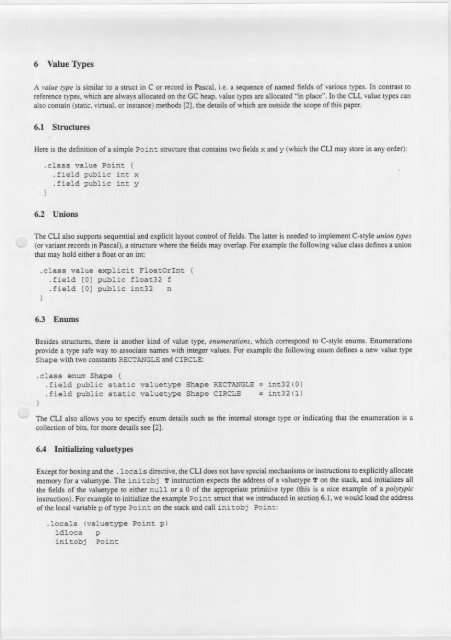The PowerPC 604 RISC Microprocessor - eisber.net
The PowerPC 604 RISC Microprocessor - eisber.net
The PowerPC 604 RISC Microprocessor - eisber.net
You also want an ePaper? Increase the reach of your titles
YUMPU automatically turns print PDFs into web optimized ePapers that Google loves.
6 Value TypesA value type is similar to a struct in C or record in Pascal, i.e. a sequence of named fields of various types. In contrast toreference types, which are always allocated on the GC heap, value types are allocated "in place". In the CLI, value types canalso contain (static, virtual, or instance) methods [2), the details of which are outside the scope of this paper.6.1 StructuresHere is the definition of a simple Point structure that contains two fields x and y (which the CLI may store in any order):.class value Point {.field public int x.field public int y}6.2 Unions<strong>The</strong> CLI also supports sequential and explicit layout control of fields. <strong>The</strong> latter is needed to implement C-style union types(or variant records in Pascal), a structure where the fields may overlap. For example the following value class defines a unionthat may hold either a float or an int:.class value explicit FloatOrint {.field [0] public float32 f.field [0] public int32 n6.3 EnumsBesides structures, there is another kind of value type, enumerations, which correspond to C-style enums. Enumerationsprovide a type safe way to associate names with integer values. For example the following enum defines a new value typeShape with two constants RECTANGLE and CIRCLE:.class enum Shape {.field public static valuetype Shape RECTANGLE = int32(0).field public static valuetype Shape CIRCLE = int32(1)<strong>The</strong> CLI also allows you to specify enum details such as the internal storage type or indicating that the enumeration is acollection of bits, for more details see [2].6.4 Initializing valuetypesExcept for boxing and the .1 oc a I s directive, the CLI does not have special mechanisms or instructions to explicitly allocatememory for a valuetype. <strong>The</strong> ini tobj T instruction expects the address of a valuetype T on the stack, and initializes allthe fields of the valuetype to either null or a 0 of the appropriate primitive type (this is a nice example of a polytypicinstruction). For example to initialize the example Po int struct that we introduced in section 6.1, we would load the addressof the local variable p of type Point on the stack and call ini tobj Point:.locals (valuetype Point p)ldloca pinitobj Point


